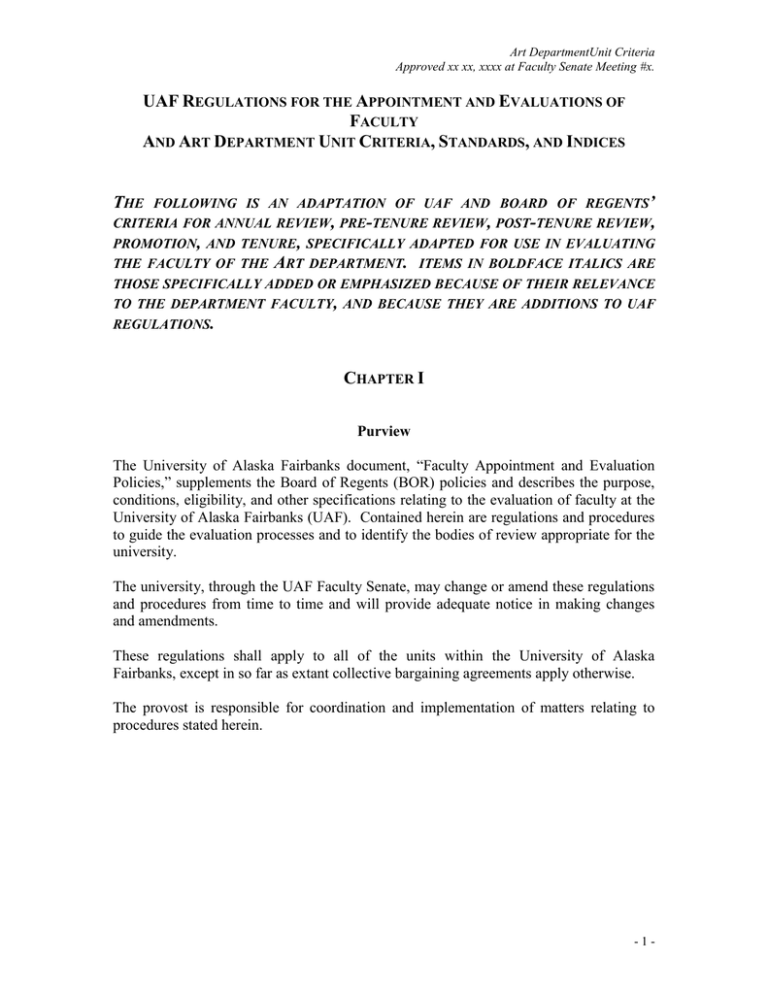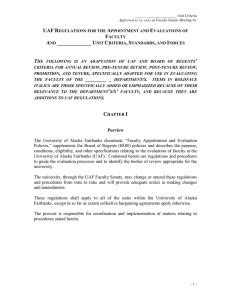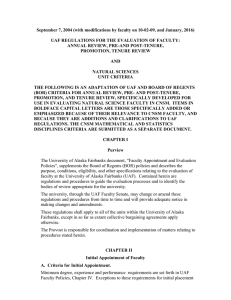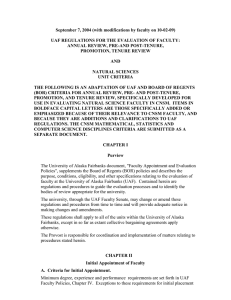UAF R A E
advertisement

Art DepartmentUnit Criteria Approved xx xx, xxxx at Faculty Senate Meeting #x. UAF REGULATIONS FOR THE APPOINTMENT AND EVALUATIONS OF FACULTY AND ART DEPARTMENT UNIT CRITERIA, STANDARDS, AND INDICES FOLLOWING IS AN ADAPTATION OF UAF AND BOARD OF REGENTS’ CRITERIA FOR ANNUAL REVIEW, PRE-TENURE REVIEW, POST-TENURE REVIEW, PROMOTION, AND TENURE, SPECIFICALLY ADAPTED FOR USE IN EVALUATING THE FACULTY OF THE ART DEPARTMENT. ITEMS IN BOLDFACE ITALICS ARE THOSE SPECIFICALLY ADDED OR EMPHASIZED BECAUSE OF THEIR RELEVANCE TO THE DEPARTMENT FACULTY, AND BECAUSE THEY ARE ADDITIONS TO UAF REGULATIONS. THE CHAPTER I Purview The University of Alaska Fairbanks document, “Faculty Appointment and Evaluation Policies,” supplements the Board of Regents (BOR) policies and describes the purpose, conditions, eligibility, and other specifications relating to the evaluation of faculty at the University of Alaska Fairbanks (UAF). Contained herein are regulations and procedures to guide the evaluation processes and to identify the bodies of review appropriate for the university. The university, through the UAF Faculty Senate, may change or amend these regulations and procedures from time to time and will provide adequate notice in making changes and amendments. These regulations shall apply to all of the units within the University of Alaska Fairbanks, except in so far as extant collective bargaining agreements apply otherwise. The provost is responsible for coordination and implementation of matters relating to procedures stated herein. -1- Art DepartmentUnit Criteria Approved xx xx, xxxx at Faculty Senate Meeting #x. CHAPTER II Initial Appointment of Faculty A. Criteria for Initial Appointment Minimum degree, experience and performance requirements are set forth in “UAF Faculty Appointment and Evaluation Policies,” Chapter IV. Exceptions to these requirements for initial placement in academic rank or special academic rank positions shall be submitted to the chancellor or chancellor’s designee for approval prior to a final selection decision. B. Academic Titles Academic titles must reflect the discipline in which the faculty are appointed. C. Process for Appointment of Faculty with Academic Rank Deans of schools and colleges, and directors when appropriate, in conjunction with the faculty in a unit, shall observe procedures for advertisement, review, and selection of candidates to fill any vacant faculty position. These procedures are set by UAF Human Resources and the Campus Diversity and Compliance (AA/EEO) office and shall provide for participation in hiring by faculty and administrators as a unit. D. Process for Appointment of Faculty with Special Academic Rank Deans and/or directors, in conjunction with the faculty in a unit, shall establish procedures for advertisement, review, and selection of candidates to fill any faculty positions as they become available. Such procedures shall be consistent with the university’s stated AA/EEO policies and shall provide for participation in hiring by faculty and administrators in the unit. E. Following the Selection Process The dean or director shall appoint the new faculty member and advise him/her of the conditions, benefits, and obligations of the position. If the appointment is to be at the professor level, the dean/director must first obtain the concurrence of the chancellor or chancellor’s designee. F. Letter of Appointment The initial letter of appointment shall specify the nature of the assignment, the percentage emphasis that is to be placed on each of the parts of the faculty responsibility, mandatory year of tenure review, and any special conditions relating to the appointment. This letter of appointment establishes the nature of the position and, while the percentage of emphasis for each part may vary with each workload distribution as specified in the annual workload agreement document, the part(s) defining the position may not. -2- Art DepartmentUnit Criteria Approved xx xx, xxxx at Faculty Senate Meeting #x. CHAPTER III Periodic Evaluation of Faculty A. General Criteria Criteria as outlined in “UAF Faculty Appointment and Evaluation Policies,” Chapter IV, evaluators may consider, but shall not be limited to, whichever of the following are appropriate to the faculty member’s professional obligation: mastery of subject matter; effectiveness in teaching; achievement in research, scholarly, and creative activity; effectiveness of public service; effectiveness of university service; demonstration of professional development and quality of total contribution to the university. For purposes of evaluation at UAF, the total contribution to the university and activity in the areas outlined above will be defined by relevant activity and demonstrated competence from the following areas: 1) effectiveness in teaching; 2) achievement in scholarly activity; and 3) effectiveness of service. Bipartite Faculty Bipartite faculty are regular academic rank faculty who fill positions that are designated as performing two of the three parts of the university’s tripartite responsibility. The dean or director of the relevant college/school shall determine which of the criteria defined above apply to these faculty. Bipartite faculty may voluntarily engage in a tripartite function, but they will not be required to do so as a condition for evaluation, promotion, or tenure. B. Criteria for Instruction A central function of the university is instruction of students in formal courses and supervised study. Teaching includes those activities directly related to the formal and informal transmission of appropriate skills and knowledge to students. The nature of instruction will vary for each faculty member, depending upon workload distribution and the particular teaching mission of the unit. Instruction includes actual contact in classroom, correspondence or electronic delivery methods, laboratory or field and preparatory activities, such as preparing for lectures, setting up demonstrations, and preparing for laboratory experiments, as well as individual/independent study, tutorial sessions, evaluations, correcting papers, and determining grades. Other aspects of teaching and instruction extend to undergraduate and graduate academic advising and counseling, training graduate students and serving on their graduate committees, particularly as their major advisor, curriculum development, and academic recruiting and retention activities. CURATORS AT THE UNIVERSITY OF ALASKA MUSEUM OF THE NORTH WITH A FACULTY APPOINTMENT IN ART TYPICALLY HAVE A PORTION OF THEIR WORKLOAD ASSIGNED IN -3- Art DepartmentUnit Criteria Approved xx xx, xxxx at Faculty Senate Meeting #x. TEACHING TO THE DEPARTMENT. THE ART DEPARTMENT WILL EVALUATE THE CURATOR’S TEACHING RECORD 1. Effectiveness in Teaching Evidence of excellence in teaching may be demonstrated through, but not limited to, evidence of the various characteristics that define effective teachers. Effective teachers a. are highly organized, plan carefully, use class time efficiently, have clear objectives, have high expectations for students; b. express positive regard for students, develop good rapport with students, show interest/enthusiasm for the subject; c. emphasize and encourage student participation, ask questions, frequently monitor student participation for student learning and teacher effectiveness, are sensitive to student diversity; f. d. emphasize regular feedback to students and reward student learning success by providing insightful critiques in an individual or group context, THE ABILITY TO RUN EFFECTIVE, CORDIAL AND INSIGHTFUL GROUP CRITIQUES IS ALSO IMPORTANT; e. demonstrate content mastery, discuss current information and divergent points of view, relate topics to other disciplines, deliver material at the appropriate level; g. regularly develop new courses, teaching residencies, workshops and seminars and use a variety of methods of instructional delivery and instructional design; h. may receive prizes and awards for excellence in teaching. i. THE “HANDS ON” NATURE OF STUDIO ART MUST BE RECOGNIZED. DEMONSTRATE TECHNICAL MASTERY AND THE ACQUISITION OF NEW TECHNIQUES INCLUDING DIGITAL MEDIA, DATABASES AND THE INTERNET. 2. Components of Evaluation -4- Art DepartmentUnit Criteria Approved xx xx, xxxx at Faculty Senate Meeting #x. Effectiveness in teaching will be evaluated through information on formal and informal teaching, course and curriculum material, recruiting and advising, training/guiding graduate students, etc., provided by: a. systematic student ratings, i.e. student opinion of instruction summary forms, and at least two of the following: b. narrative self-evaluation, c. peer/department chair classroom observation(s), d. peer/department chair evaluation of course materials. C. Criteria for Research, Scholarly, and Creative Activity Inquiry and originality are central functions of a land grant/sea grant/space grant university and all faculty with a research component in their assignment must remain active as scholars. Consequently, faculty are expected to conduct research or engage in other scholarly or creative pursuits that are appropriate to the mission of their unit, and equally important, results of their work must be disseminated through media appropriate to their discipline. Furthermore, it is important to emphasize the distinction between routine production and creative excellence as evaluated by an individual's peers at the University of Alaska and elsewhere. ART FACULTY ARE EXPECTED TO CONSISTENTLY CREATE AND EXHIBIT NEW WORK. THE STATURE OF THE EXHIBITION SPACE AND SCALE OF THE EXHIBIT SHOULD ALSO BE CONSIDERED. NOTE THAT AN ART HISTORIAN’S RESEARCH WILL BE LARGELY PRESENTATION, PUBLICATION, AND CURATORIAL WHILE A STUDIO ARTIST’S WILL BE LARGELY EXHIBITION BASED. A DIGITAL ARTIST WILL NORMALLY PRESENT WORK IN WEB BASED OR OTHER DIGITAL FORMAT. STUDIO ARTISTS, BOTH TRADITIONAL MEDIA AND DIGITAL, NORMALLY MAKE PUBLIC SPEAKING PRESENTATIONS AS A PART OF THEIR WORK. CURATORS AT THE UNIVERSITY OF ALASKA MUSEUM OF THE NORTH WITH A FACULTY APPOINTMENT IN ART TYPICALLY HAVE A PORTION OF THEIR WORKLOAD ASSIGNED TO THE DEPARTMENT. THE ART DEPARTMENT WILL EVALUATE THE CURATOR’S CREATIVE ACTIVITY AND RESEARCH RECORD. 1. Achievement in Research, Scholarly and Creative Activity Whatever the contribution, research, scholarly or creative activities must have one or more of the following characteristics: a. They must occur in a public forum. -5- Art DepartmentUnit Criteria Approved xx xx, xxxx at Faculty Senate Meeting #x. b. They must be evaluated by appropriate peers. c. They must be evaluated by peers external to this institution so as to allow an objective judgment. d. They must be judged to make a contribution. 2. Components of Research, Scholarly and Creative Activity Evidence of excellence in research, scholarly, and creative activity may be demonstrated through, but not limited to: a. Books, reviews, monographs, bulletins, articles, proceedings, CATALOGS and other scholarly works published by reputable journals, scholarly presses, and publishing houses that accept works only after rigorous review and approval by peers in the discipline. ONLINE MAGAZINES AND OTHER DIGITAL PUBLICATIONS ARE VALID VENUES IF SUBJECT TO REVIEW AND APPROVAL BY PEERS. b. Competitive grants and contracts to finance the development of ideas, these grants and contracts being subject to rigorous peer review and approval. c. Presentation of research papers before learned societies that accept papers only after rigorous review and approval by peers. d. Exhibitions of art work at galleries, MUSEUMS, ART CENTERS AND ALTERNATIVE SPACES AS WELL AS SITE SPECIFIC LOCATIONS, selection for these exhibitions being based on rigorous review and approval by juries, recognized artists, or critics. BOTH JURIED AND INVITATIONAL GROUP AND SOLO EXHIBITS ARE VALID FORUMS. ONLINE VENUES ARE ALSO APPROPRIATE FOR DIGITAL WORK EXHIBITION. THE SELECTION PROCESS FOR EXHIBITIONS IS COMPETITIVE AND COMPARABLE TO PUBLISHING IN REFEREED JOURNALS. SOLO EXHIBITIONS SHOULD TAKE PLACE EVERY TWO YEARS ON AVERAGE AND PARTICIPATION IN JURIED OR INVITATIONAL GROUP SHOWS SHOULD TAKE PLACE FREQUENTLY, ON AVERAGE AT LEAST TWO TIMES A YEAR. e. SOLO AND COLLABORATIVE performances in recitals or productions, selection for these performances being based on stringent auditions and approval by appropriate judges. f. Scholarly reviews of publications, art works and performance of the candidate. g. Citations of research in scholarly publications. -6- Art DepartmentUnit Criteria Approved xx xx, xxxx at Faculty Senate Meeting #x. h. Published abstracts of research papers. i. Reprints or quotations of publications, reproductions of art works, and descriptions of interpretations in the performing arts, these materials appearing in reputable works of the discipline. j. Prizes and awards for excellence of scholarship, INCLUDING ACQUISITION OF WORK BY PROMINENT PRIVATE, CORPORATE AND PUBLIC COLLECTIONS. l. Awards of special fellowships for research or artistic activities or selection of tours of duty at special institutes for advanced study, including artist-inresidences. m. Development of processes or instruments useful in solving problems, such as computer programs and systems for the processing of data, genetic plant and animal material, and where appropriate obtaining patents and/or copyrights for said development. n. CREATION OF PUBLIC ART COMMISSIONED BY LOCAL, STATE OR NATIONAL GOVERNMENT OR PRIVATE ORGANIZATIONS. o. APPLIED RESEARCH SUCH AS BUILDING AND DESIGN OF EQUIPMENT OR PROCESSES USING HISTORICAL AND/OR CONTEMPORARY TECHNOLOGIES. p. SERVING AS CURATOR OF AN EXHIBIT AT A RECOGNIZED INSTITUTION SUCH AS A MUSEUM, GALLERY OR ALTERNATIVE SPACE. q. PUBLIC SCREENING AND BROADCAST OF VIDEO/FILM WORKS. D. Criteria for Public and University Service Public service is intrinsic to the land grant/sea grant/space grant tradition, and is a fundamental part of the university’s obligation to the people of its state. In this tradition, faculty providing their professional expertise for the benefit of the university’s external constituency, free of charge, is identified as “public service.” The tradition of the university itself provides that its faculty assumes a collegial obligation for the internal functioning of the institution; such service is identified as “university service.” 1. Public Service Public service is the application of teaching, research, and other scholarly and creative activity to constituencies outside the University of Alaska Fairbanks. It -7- Art DepartmentUnit Criteria Approved xx xx, xxxx at Faculty Senate Meeting #x. includes all activities which extend the faculty member’s professional, academic, or leadership competence to these constituencies. It can be instructional, collaborative, or consultative in nature and is related to the faculty member’s discipline or other publicly recognized expertise. Public service may be systematic activity that involves planning with clientele and delivery of information on a continuing, programmatic basis. It may also be informal, individual, professional contributions to the community or to one’s discipline, or other activities in furtherance of the goals and mission of the university and its units. Such service may occur on a periodic or limited-term basis. Examples include, but are not limited to: a. Providing information services to adults or youth. b. Service on or to government or public committees. c. Service on accrediting bodies. d. Active participation in professional organizations. e. Active participation in discipline-oriented service organizations. f. Consulting. g. Prizes and awards for excellence in public service. h. Leadership of or presentations at workshops, conferences, or public meetings. i. Training and facilitating. j. Radio and TV programs, newspaper articles and columns, publications, newsletters, films, computer applications, teleconferences and other educational media. k. Judging and similar educational assistance at science fairs, state fairs, and speech, drama, literary, and similar competitions. 2. University Service University service includes those activities involving faculty members in the governance, administration, and other internal affairs of the university, its colleges, schools, and institutes. It includes non-instructional work with students and their organizations. Examples of such activity include, but are not limited to: a. Service on university, college, school, institute, or departmental committees or governing bodies. -8- Art DepartmentUnit Criteria Approved xx xx, xxxx at Faculty Senate Meeting #x. b. Consultative work in support of university functions, such as expert assistance for specific projects. c. Service as department chair or term-limited and part-time assignment as assistant/associate dean in a college/school. d. Participation in accreditation reviews. e. Service on collective bargaining unit committees or elected office. f. Service in support of student organizations and activities. g. Academic support services such as library and museum programs. h. Assisting other faculty or units with curriculum planning and delivery of instruction, such as serving as guest lecturer. i. Mentoring. j. Prizes and awards for excellence in university service. 3. Professional Service a. Editing or refereeing articles or proposals for professional journals or organizations. b. Active participation in professional organizations. c. Active participation in discipline-oriented service organizations. d. Committee chair or officer of professional organizations. e. Organizer, session organizer, or moderator for professional meetings. f. Service on a national or international review panel or committee. 4. Other Service: Curation CURATORS AT THE UNIVERSITY OF ALASKA MUSEUM OF THE NORTH (UAMN) WITH A FACULTY APPOINTMENT IN ART TYPICALLY HAVE A PORTION OF THEIR WORKLOAD ASSIGNED TO THE DEPARTMENT. THE ART DEPARTMENT WILL EVALUATE THE CURATOR’S SERVICE RECORD TAKING INTO CONSIDERATION THE RECOMMENDATION OF THE UAF MUSEUM COMMITTEE. CURATION INVOLVES THE MANAGEMENT AND DEVELOPMENT OF A FORMALLY RECOGNIZED UNIVERSITY COLLECTION THAT EXISTS TO SERVE AS A RESEARCH RESOURCE FOR STUDENTS AND -9- Art DepartmentUnit Criteria Approved xx xx, xxxx at Faculty Senate Meeting #x. RESEARCHERS AT UNIVERSITY, STATE, NATIONAL, AND INTERNATIONAL LEVELS. EXAMPLES OF CURATORIAL ACTIVITIES INCLUDE, BUT ARE NOT LIMITED TO: a. MAINTAINING, ENHANCING, AND ENLARGING THE COLLECTION (INCLUDES COMPUTERIZATION AND DATABASE DEVELOPMENT, ARCHIVAL UPGRADES, SPECIMEN CONSERVATION AND IDENTIFICATION, AND ADDING SPECIMENS OR OBJECTS TO EXISTING COLLECTION); b. INTERACTING WITH STATE AND FEDERAL AGENCIES AND WITH THE PUBLIC ON COLLECTIONS-RELATED ISSUES; c. FACILITATING COLLECTIONS USE THROUGH LOANS, EXCHANGES, AND VISITING RESEARCHERS; d. MAINTAINING APPROPRIATE PERMITS (AS NEEDED FOR THE COLLECTIONS); e. DIRECTING COLLECTIONS MANAGERS, STUDENT EMPLOYEES, AND VOLUNTEERS; f. WORKING WITH PUBLIC PROGRAM STAFF TO CREATE EXHIBITS AND EDUCATIONAL ACTIVITIES APPROPRIATE TO THE COLLECTION; g. PURSUING FUNDING FOR COLLECTIONS GROWTH AND MAINTENANCE; h. PRODUCING CURATORIAL OR COLLECTIONS-RELATED PUBLICATIONS, REPORTS, AND/OR MANUALS. i. ENSURING UNIVERSITY COMPLIANCE WITH STATE AND FEDERAL LAWS THAT PERTAIN TO THE COLLECTION. j. SPECIFIC CRITERIA FOR CURATORIAL PERFORMANCE AT THE RANK OF ASSISTANT PROFESSOR. EVIDENCE OF CURATORIAL ABILITY AND A COMMITMENT TO DEVELOPING AND MANAGING RESEARCH COLLECTIONS RELEVANT TO THE AREA OF SPECIALIZATION INCLUDES THE FOLLOWING: i. CURATORS WILL DEVELOP THE COLLECTIONS AS A PERMANENT RECORD OF THE NATURAL AND/OR CULTURAL DIVERSITY OF ALASKA AND THE CIRCUMPOLAR NORTH AND AS A RESEARCH RESOURCE FOR STUDIES OF BIOLOGICAL AND/OR CULTURAL DIVERSITY. - 10 - Art DepartmentUnit Criteria Approved xx xx, xxxx at Faculty Senate Meeting #x. ii. COLLECTIONS CARE INCLUDES RESPONSIBILITY FOR THE PHYSICAL CONDITION AND STORAGE OF OBJECTS/SPECIMENS, CORRESPONDING DOCUMENTATION, BUDGETARY MANAGEMENT, AND ANNUAL REPORTS. iii. CURATORS WILL PRESERVE THE SPECIMENS, ARTIFACTS, OBJECTS, AND MATERIAL UNDER THEIR PURVIEW THROUGH THE USE OF METHODS AND TECHNIQUES PROFESSIONALLY ACCEPTED WITHIN THEIR RESPECTIVE DISCIPLINES. iv. CURATORS WILL ENSURE THAT ALL RECORDS AND FIELD NOTES CONCERNING COLLECTION MATERIALS ARE MAINTAINED IN A SECURE FASHION AND MEET OR EXCEED DOCUMENTATION STANDARDS FOR THEIR RESPECTIVE DISCIPLINE. v. CURATORS WILL MAINTAIN CURRENT ACCESSION FILES, DEACCESSION FILES, AND CATALOGUES OF OBJECTS IN THEIR COLLECTIONS. THEY WILL DEVELOP ELECTRONIC DATABASES WITH COMPUTER DATA FORMATS THAT FOLLOW DATA STANDARDS OF THE RESPECTIVE DISCIPLINE AND UAMN. vi. CURATORS WILL DEVELOP, MAINTAIN, AND REVISE WRITTEN POLICIES AND PROCEDURES FOR CURATION CAUTION OF OBJECTS OR SPECIMENS IN THEIR COLLECTIONS. vii. CURATORS WILL TAKE PART IN INTERPRETIVE ACTIVITIES OF THE MUSEUM IN ORDER TO FULFILL THE MUSEUM’S MISSION TO INTERPRET THE NATURAL AND CULTURAL HISTORY OF ALASKA. IN THIS REGARD, PREPARATION OF SMALL EXHIBIT IS APPROXIMATELY THE EQUIVALENTS OF PUBLICATION OF A PROFESSIONAL ARTICLE; PROJECT DIRECTION OF A LARGE COMPLEX EXHIBIT THAT INCLUDES PREPARATION OF A SERIOUS CATALOGUE IS APPROXIMATELY THE EQUIVALENT OF PUBLICATION OF A SCHOLARLY BOOK. viii. CURATORS WILL ACTIVELY PREPARE GRANT APPLICATIONS FOR EXTERNAL SUPPORT FOR THEIR CURATORIAL ACTIVITIES AND COLLECTION-BASED RESEARCH. k. SPECIFIC CRITERIA FOR CURATORIAL PERFORMANCE AT THE RANK OF ASSOCIATE PROFESSOR - 11 - Art DepartmentUnit Criteria Approved xx xx, xxxx at Faculty Senate Meeting #x. CONSISTENT CONTRIBUTIONS TO INTERPRETIVE (EDUCATION AND EXHIBITION) ACTIVITIES OF THE MUSEUM, RESPONSE TO COLLECTION-RELATED INQUIRIES (FROM OTHER PROFESSIONALS, THE PUBLIC AND STATE AGENCIES) AND/OR DEVELOPMENT OF INTERPRETIVE MATERIALS FOR THE PUBLIC-AT-LARGE ARE EXPECTED. USE OF THE COLLECTIONS FOR TEACHING AND/OR RESEARCH MUST BE EVIDENT. ACTIVE SOLICITATION FOR EXTERNAL FUNDS TO SUPPORT CURATORIAL ACTIVITIES AND COLLECTION-BASED RESEARCH MUST BE EVIDENT. l. SPECIFIC CRITERIA FOR CURATORIAL PERFORMANCE AT THE RANK OF PROFESSOR SIGNIFICANT DEVELOPMENT OF THE COLLECTIONS UNDER THE CURATOR’S CARE IS EXPECTED. THIS DEVELOPMENT INCLUDES SUSTAINED GROWTH OF THE COLLECTIONS AS RESEARCH RESOURCES AND AS A MEANS OF FULFILLING THE MUSEUM’S MISSION OF ACQUIRING, PRESERVING IN PERPETUITY, INVESTIGATING, AND INTERPRETING OBJECTS AND SPECIMENS RELATING TO THE NATURAL AND OR CULTURAL HISTORY OF ALASKA AND THE CIRCUMPOLAR NORTH. SIGNIFICANCE OF COLLECTIONS WILL BE MEASURED IN TERMS OF RESEARCH SIGNIFICANCE, VALUE TO UNIVERSITY OF ALASKA RESEARCH AND INSTRUCTIONAL PROGRAMS, AND VALUE TO NATIONAL AND INTERNATIONAL RESEARCH PROGRAMS. THE CURATOR SHOULD BE A RECOGNIZED AUTHORITY IN HIS/HER FIELD, LOCALLY AND NATIONALLY. THEY MUST HAVE A RECORD OF SUCCESS IN ACQUIRING EXTERNAL FUNDS FOR THEIR CURATORIAL ACTIVITIES AND COLLECTION-BASED RESEARCH. 5. Evaluation of Service Each individual faculty member’s proportionate responsibility in service shall be reflected in annual workload agreements. In formulating criteria, standards and indices for evaluation, promotion, and tenure, individual units should include examples of service activities and measures for evaluation appropriate for that unit. Excellence in public and university service may be demonstrated through, e.g., appropriate letters of commendation, recommendation, and/or appreciation, certificates and awards and other public means of recognition for services rendered. CURATORS AT THE UNIVERSITY OF ALASKA MUSEUM OF THE NORTH WITH A FACULTY APPOINTMENT IN ART TYPICALLY HAVE A PORTION OF THEIR WORKLOAD ASSIGNED TO THE DEPARTMENT. THE ART DEPARTMENT WILL EVALUATE THE CURATOR’S SERVICE - 12 - Art DepartmentUnit Criteria Approved xx xx, xxxx at Faculty Senate Meeting #x. RECORD TAKING INTO CONSIDERATION THE RECOMMENDATION OF THE UAF MUSEUM COMMITTEE. - 13 -


